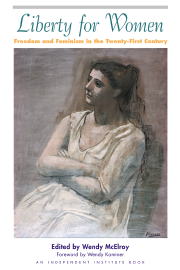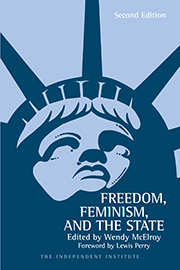A legion of the politically correct who make a living from the alleged oppression of women were gleeful and almost goofy with proofiness this week. The incident is a window into how statistical myths are created.
Charles Seife, a journalist and a professor at New York University, coined the term proofiness as a corollary to an earlier term coined by comedian Stephen Colbert: truthiness. Truthiness was defined as "the quality of preferring concepts or facts one wishes to be true, rather than concepts or facts known to be true." It became the American Dialect Society’s 2005 Word of the Year because it embodied a cultural zeitgeist that haunted the socio-political narrative of our time.
Proofiness is "the art of using bogus mathematical arguments to prove something that you know in your heart is true—even when it’s not." It should have been the Word of the Year for 2010 when Seife’s book Proofiness: The Dark Arts of Mathematical Deception was published. A new study gives the term a second chance for fame, as it points to the dark side of math.
The Latest "Men Are Evil" ’Study’
"Denying Rape but Endorsing Forceful Intercourse: Exploring Differences Among Responders" is a ’study’ at the University of North Dakota, Grand Forks, which has just been released by the portentiously named journal Violence and Gender. It claims that approximately 1 in 3 male students would rape their female counterparts "if nobody would ever know and there wouldn’t be any consequences." The study is almost a classic example of proofiness.
It almost descends to the level of "Potemkin data." The phrase refers to Russian lore in which Gregory Potemkin erected fake settlements along the Dnieper River in order to deceptively impress his paramour Catherine II as she toured the newly acquired Crimea (1787). The faux villages were akin to movie props with no substance behind their fronts. Potemkin wished to trick Catherine into believing a situation was better than it really was. The North Dakota ’study’ wants people to believe a situation is worse than it really is. Except, of course, for those to whom political correctness is a profession or a moral crusade. To them, the finding of male depravity is good news because it means another paycheck and another false stat about which to be self-righteous.
The ’study’ is a classical example of how to construct Potemkin data. Some of the characteristics this includes:
Start with deeply biased researchers. Led by psychology professor Sarah R. Edwards, the researchers state within the ’study’: "Given that callous sexual attitudes permit violence and consider women as passive sexual objects, it follows that for men who endorse these, sexual aggression becomes an appropriate and accepted expression of masculinity. In this sense, using force to obtain intercourse does not become an act of rape, but rather an expression of hyper-masculinity, which may be thought of as a desirable disposition in certain subcultures." (p.189)
Proceed from a false premise or assumption. The opening sentence of the ’study’ states, "Federal data estimate that about one in five women becomes the victim of sexual assault while in college, most of which is committed by assailants known to the victim" (National Center for Injury Prevention and Control 2012). The 1-in-5 figure has been exhaustively debunked for many months and should be rendered unresurrectable by the Bureau of Justice Statistics (BJS) report (12/14) that found the actual rate of rape to be 0.61 percent per year—or 6.1 per 1,000 students.
Use a ridiculously small sample that is selective and drawn from one source. Of the approximately 15,000 students at the university in question, 86 male students were surveyed and 73 answers were used for analysis. Of these, 23 respondents were considered to have expressed "intentions to force a woman to sexual intercourse."
Further bias the sample by adding incentives. The Mary Koss study from which the 1 in 4 rape stat derives offered a $10 gift card for anonymous and self-reporting participation. The Edwards study offered extra university credit to participants. The incentive may have encouraged answers that the students thought the researchers wished to hear so as to complete the process and receive the credit.
Or the participants may have blown off the questions. The intrepid Ashe Schow commented in the Washington Examiner (13/01/15): "Even in a world where college men take everything seriously, nine guys does not equal a mass epidemic of would-be rapists. A more sound reading is that nine college boys didn’t take the survey too seriously."
Ask questions that skew participants toward the desired answer. The researchers specified that the imaginary rape would never be discovered and would have no consequences. How many people would admit to seriously considering murder at some point – e.g., of an ex-spouse, a swindling partner, an assailant – if the murder was guaranteed to be unknown and consequence-free? By removing the imagined rape from the real world, non-real rates are achieved.
Draw upon prestigious but dubious authority. Sources welcoming the prospect of rapacious men frequently mention that the ’study’ was peer reviewed. But, since research became a political tool circa the 1980s, peer review means increasingly little. Consider the peer-reviewed study "The Role of Conspiracist Ideation and Worldviews in Predicting Rejection of Science" in PLOS ONE (2013). The researcher found that age did not correlate with indicator factors. When a single self-reported age was removed from the sample (post-publication), age didcorrelate. The deleted sample was a 32,757-year-old person.
And, then, there was the study upon which Slate (11/11/2014) commented in an article entitled, "This Is What Happens When No One Proofreads an Academic Paper." The study "Variation in Melanism and Female Preference in Proximate but Ecologically Distinct Environments" appeared in the peer-reviewed journal Ethology. The published paper included a candid question intended for peer readers; the researcher asked, "Should we cite the crappy Gabor paper here?"
Meanwhile, never admit there is sound contradicting evidence. A Huffington Post article (09/01/15) reported, "Another 2002 study by David Lisak at the University of Massachusetts-Boston, speaking with 1,882 men, found 120 had committed rape or attempted rape."
State the researchers’ subjective conclusions based on their beliefs. The ’study’ declares of the rapacious males, "We believe that men exhibiting higher levels of hostility toward women will exhibit awareness that their behaviors constitute rape, and still endorse use of force given that the motivation of the encounter is to punish women." (p.189)
The Why of the Edwards ’Study’
The most insidious aspect of the ’study’ is one of the least commented upon. It is an attempt to reconcile a fact that has embarrassed and encumbered the 1-in-4 rate of female rape statistic upon which so much politics rests. Fully 73% of the women identified as rape victims in the pivotal Koss study said they had not been raped. Koss deliberately dismissed them and categorized them according to her own perceptions and needs. Otherwise stated, only 27% agreed with Koss’s assessment of their experience.
How does a researcher justify the unmitigated arrogance and dishonesty of dismissing data in order to fit an agenda? By claiming the participant does not understand the meaning of their own words or feelings ... but the researcher does. In an unskeptical Newsweek article (09/01/15), Edwards claimed that "the No. 1 point [of the study] is there are people that will say they would force a woman to have sex but would deny they would rape a woman." This statement was meant to explain the extreme discrepancy between men who reported a willingness to use force but not to rape; 31.7%, on which 1 in 3 is based, as opposed to 13.6% or 1 in 14. Edwards stated the conclusion of the ’study’ as "when survey items describe behaviors ... instead of simply label[ling] them ... more men will admit to sexually coercive behaviors in the past and more women will self-report past victimization." [Emphasis added]
The Newsweek article commented on a recent MIT survey that must have been a disappointment to rape culture zealots. It stated, "[O]nly 10 percent of those MIT women also said yes when asked if they were sexually assaulted, and just 5 percent said yes when asked if they were raped." But if the participants did not know the truth of their own experiences – and the researcher did – then those rates might soar.
The game of explaining away women’s disappointing reports of their own experience is afoot. The game of defending the 1-in-4 stat is on. Women’s voices be damned.









